
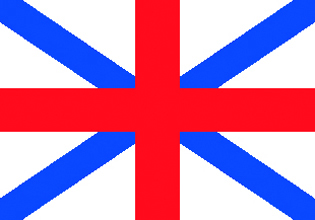 The twin screw passenger cargo-liner Port Jackson was memorable for two reasons, firstly she was the first ship in the Port Line fleet to have a continuous long Bridge Deck, and secondly her design set a standard and was used as the prototype of eight further sisters or similar ships. She was named after the inlet on the east coast of Australia that Capt. Cook discovered in 1770, but he sailed on to conduct his surveying work further down the coast to Botany Bay, and it was left to Capt. Philip eighteen years later to venture into the inlet and discover Sydney Harbour with his big contingent of eleven ships carrying marines, settlers and convicts. This ‘First Fleet’ had sailed from Portsmouth on 13th May 1787 and dropped anchor in Sydney Cove on 26th January 1788, and was escorted by two Royal Navy ships, Sirius and Supply. The convict ships were Alexander, Charlotte, Friendship, Lady Penrhyn, Prince of Wales and Scarborough, and the store ships were Borrowdale, Fishburn and Golden Grove.
The twin screw passenger cargo-liner Port Jackson was memorable for two reasons, firstly she was the first ship in the Port Line fleet to have a continuous long Bridge Deck, and secondly her design set a standard and was used as the prototype of eight further sisters or similar ships. She was named after the inlet on the east coast of Australia that Capt. Cook discovered in 1770, but he sailed on to conduct his surveying work further down the coast to Botany Bay, and it was left to Capt. Philip eighteen years later to venture into the inlet and discover Sydney Harbour with his big contingent of eleven ships carrying marines, settlers and convicts. This ‘First Fleet’ had sailed from Portsmouth on 13th May 1787 and dropped anchor in Sydney Cove on 26th January 1788, and was escorted by two Royal Navy ships, Sirius and Supply. The convict ships were Alexander, Charlotte, Friendship, Lady Penrhyn, Prince of Wales and Scarborough, and the store ships were Borrowdale, Fishburn and Golden Grove.
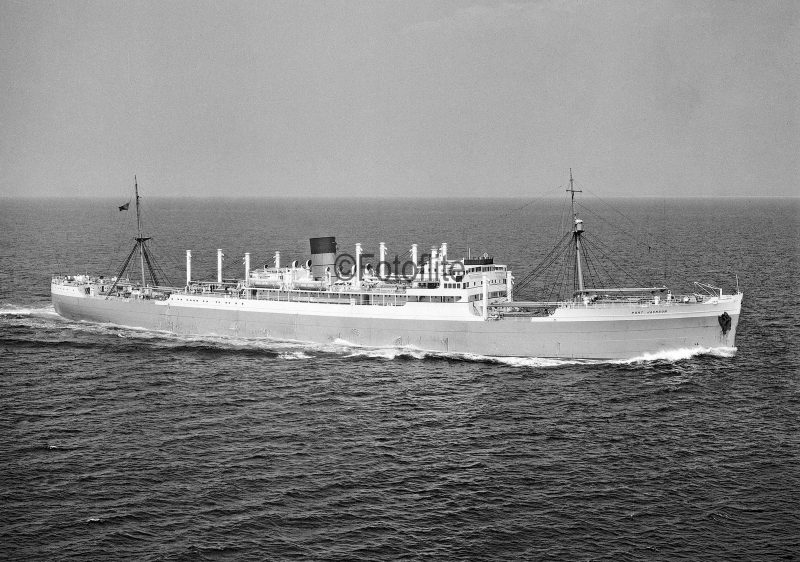
The cargo-liner Port Jackson was launched at the Wallsend yard of Swan, Hunter and Wigham Richardson Ltd. on 26th November 1936 as Yard number 1515 and completed in January 1937. She had dimensions of length 521.2 feet overall, length between perpendiculars of 495.6 feet, moulded beam of 68.3 feet, depth to Upper Deck of 41.6 feet, and loaded draft of 28.6 feet. The long continuous Bridge Deck was of length 231.0 feet, with a fo’c’stle of length 93.0 feet, and a poop of length 27.0 feet. Six cavernous holds, five of them insulated together with their Lower and Upper ‘tween decks for the carriage of refrigerated cargo, had a capacity for 743,030 cubic feet of cargo (grain), of which 494,000 cubic feet was refrigerated for perishable cargoes.
Gross tonnage worked out at 9,687 with a deadweight of 10,905 tonnes, and with a useful service speed of 16.5 knots, she entered the Australian service of her owners Port Line, better known at this time as the Commonwealth and Dominion Line (C & D) and formed on 23rd January 1914.
C & D was a merger of four companies with William Milburn of Newcastle supplying nine ships with ‘Port’ prefixes to their names from his Anglo-Australasian Steam Navigation Co. Ltd., J. P. Corry of Belfast supplying 5 ships from his Star Line, Thomas B. Royden of Liverpool supplying 3 ships from his Indra Line, and G. D. Tyser & Company of London supplying eight ships as well as one of the most beautiful white, red and blue houseflags ever seen on British ships. The company name of Port Line was changed from the Commonwealth and Dominion Line on 18th November 1937, after Port Jackson had been in service for eleven months.
Design and Specification
Port Jackson had excellent accommodation for a dozen First Class passengers in six double staterooms, all tastefully furnished in a deckhouse at the forward end of Boat Deck. The staterooms contained two single beds, with two dark stained ‘tallboys’ for hanging clothes on either side of a low table containing six drawers, three on each side, with a mirror above.
The fabric of the curtains and the upholstery of the carver easy chairs was light coloured and matching. The public rooms comprised the Dining Room, Lounge and Card Room on Promenade Deck, all beautifully decorated and fitted out as follows:-
Dining Room was entered by stairs from the deck above through two glass doors with thin wooden side frames. The tables were arranged for six or four passengers with low side serving tables for the stewards and arranged with cutlery in several drawers below. This elegant room was kept cool in tropical latitudes by cooling fans on the ceiling.
Lounge was a very elegant room entered by stairs from the deck above through two glass doors with thin wooden side frames and horizontal beeding. Partitioned areas for privacy of groups of passengers were provided by further sets of double glass doors. The wooden tables had small ‘pull out’ extensions for holding drinking glasses on each of their sides, and the light oak panelling, wall mirrors, and wall clocks gave the room a cosy, intimate feel for long periods of occupancy.
Card Room and Reading and Writing Room was furnished with small writing desks at the sides lit by thin horizontal lamps. The glass doors with thin wooden frames at their sides, dark oak panelling, and comfortable carver chairs gave the room an appearance that was exactly what was required for card games, reading or writing home.
The Boat Deck with the Navigating Bridge above were extended forwards by around ten feet in post-war years to be flush with the Promenade Deck below, and the Boat Deck was given side windows at that time. The Master’s suite of rooms was on the navigating bridge aft of the chartroom and wheelhouse. The Navigating and Engineering Officers were accommodated on Bridge Deck with comfortable smoking rooms and mess rooms, with the crew housed aft inside the poop. The fo’c’stle was used as cargo space, and the vessel was designed with six main hatches served by eighteen electric winches driving eighteen derricks of between seven and fifteen tonnes capacity fitted at the foremast, mainmast and five sets of posts. A power output of 375 kilowatts at 240 volts was supplied by three generators to drive the winches.
A comprehensive refrigerating system was installed by J. and E. Hall Ltd. of Dartford consisting of freezing brine pipe grids, fans and coolers. An important feature of this was the latest practice of specially arranged gas tight compartments to house the chilled beef hanging from hooks to allow forced free circulation of air throughout this most valuable chilled cargo carried at 15 degrees Fahrenheit. The vessel also carried other perishable cargoes e.g. butter, cheese, apples, oranges and other fruits as well as eggs, each of these commodities requiring a different temperature of circulated or still air on the very long voyage homewards from Australia or New Zealand. A large number of thermometers were fitted, either of the automatic electrical recording type or the type that were lowered into the cargo spaces through tubes. The engine room also had carbon dioxide indicators to show whether the amount of gas given off by the chilled beef or fruit cargo remained constant. Apples, in particular, carried at 45 degrees Fahrenheit gave off a large amount of carbon dioxide on a long voyage, and with this cargo in mind, extractor fans were installed in the holds which removed the gases and injected fresh air instead.
The hull was extensively electric welded, the Wallsend shipyard having gained experience in welding hulls in two coasters completed in 1933. Welding was also used for the joints of the watertight bulkheads, oil fuel bunker double bottoms, deckhouses, deck plating, masts, derrick posts and skylights. There was a duct keel forward of the machinery spaces, as well as wing tanks at either side of these spaces, with further tanks built in to each side of the propelling shaft. There were eight partly cemented bulkheads with the collision bulkhead extending up to the upper shelter deck, and the remaining bulkheads only to the second deck.
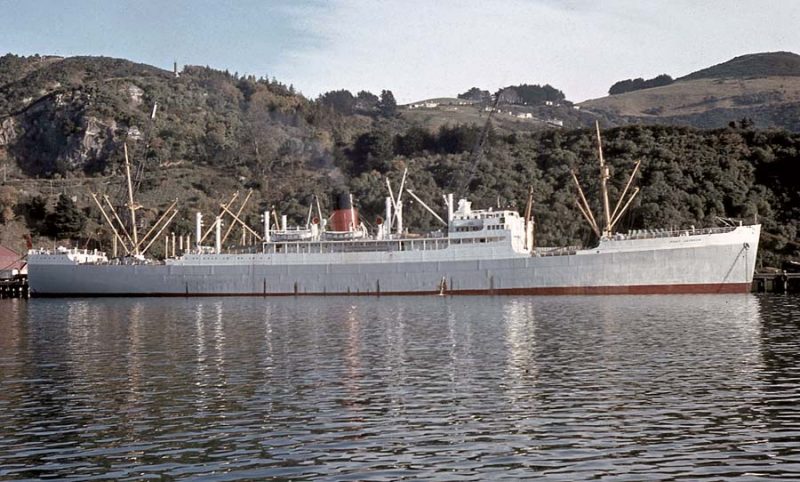
Bunker fuel capacity was 2,200 tonnes in a cellular double bottom of length 421.2 feet, with the fore peak able to hold 771 tonnes of water ballast, and the aft peak 120 tonnes. The twin four cylinder Doxford single acting four stroke cycle balanced type opposed piston reversible oil engines, gave a total of 10,200 bhp at 115 rpm. The engines were manufactured by the Barclay, Curle & Co. Ltd. yard on the Clyde and installed in the vessel at the Neptune Yard Engine Works on the Tyne. A scavenging pump was driven from each main engine crankshaft, and the engine bedplates were made of steel plate of welded construction. The auxiliaries were electrically driven, power being supplied by three direct current generators manufactured by Messrs W. H. Allen & Sons of Bedford, the normal output from each set being 375 kilowatts at 240 volts.
A waste heat boiler of the Cochran type with ‘Sinuflo’ tubes was installed, and arrangements were made by which the boiler uses a portion of the exhaust gases from the main engines. In addition, an oil fired boiler was also fitted with a working pressure of 100 lbs per square inch. A ‘Comyn’ oily water separator with an output of 100 tonnes per hour was also fitted. The manganese bronze blades of the propellers were of ‘aerofoil’ section, with the bosses being of cast iron. The navigating bridge was fitted with the very latest equipment, including a Marconi wireless direction finder, a Hughes echometer for depth readings, and a Sperry gyro compass.
The lady sponsor at her launch was Lady Hankey, wife of Sir Maurice Hankey, and the owners party at the launch and later at the dinner in the evening comprised twenty five persons, including Herbert W. Corry, Vice Chairman of Commonwealth and Dominion Line, director Robert Corry, marine superintendent H. G. Dearden, Lord and Lady Booth, Sir Leonard J. Milburn and W. A. Milburn, both of the Newcastle Milburn family of the Anglo-Australasian Steam Navigation Co. Ltd. The Wallsend yard was very grateful to the Commonwealth and Dominion Line as two orders in 1933/34 had greatly helped the yard come out of the Depression. Port Chalmers had been launched on 3rd October 1933 at Wallsend from the same slipway as the famous four funnelled Cunard liner Mauretania, and had been only the second vessel launched that year. Port Townsville followed down the same slipway on 21st May 1935, and it was very gratifying for Swan, Hunter and Wigham Richardson Ltd. to win the follow-on order for the larger Port Jackson. Port Jackson was dressed overall with flags from stem to stern for her launch, with her twin anchors and twin propellers already fitted. The beautiful red, blue and white Commonwealth and Dominion Line houseflag was intricately painted at the top of her bow, with bouquets presented to Lady Hankey before she mounted the launching platform, with two large union jacks proudly flying at each end of this dias.
Wartime Career Of Port Jackson and Her Sisters
Port Jackson sailed from the Tyne on her maiden voyage in January 1937 to load outwards in the Thames for Port Adelaide. She had thus followed in the wake of two previous Tyne built ships of the name. The first Port Jackson of 2,644 grt had sailed from the Andrew Leslie yard at Hebburn in July 1884 for her scheduled berth on the Thames for Sydney (NSW), and was also the first ever ship with a ‘Port’ prefix to her name in the Milburn shipowning family fleet of Newcastle. The second Port Jackson of 5,505 grt had been launched by Hawthorn, Leslie & Co. Ltd. at Hebburn on 19th November 1903 under that name, but was sold on during fitting out to British India Line and renamed Waipara and made her maiden voyage to Australia under that name on 24th June 1904.
Port Line lost thirteen fine vessels out of a pre-war fleet of thirty ships during World War II, with the last two of this excellent fleet still completing at the fitting out quays at Wallsend and at the North Sands yard of Joseph L. Thompson & Sons Ltd. at the outbreak. The vessels lost included two of the eight sisters or similar ships that were built from the prototype designs of Port Jackson. Port Napier (2) (Yard 1569 from Wallsend) was taken over during building and completed as the minelayer H.M.S. Port Napier in the First Minelaying Squadron in 1940.
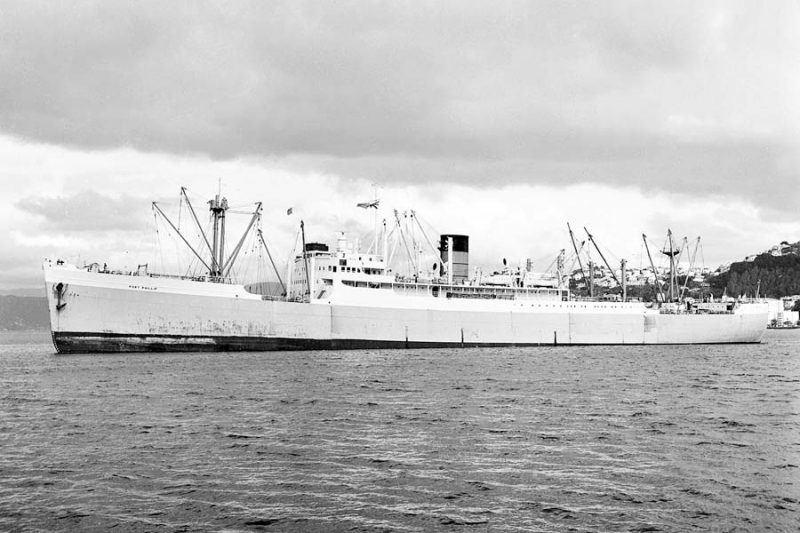
During a gale on 26th November 1940, while at anchor at Kyle of Lochalsh, the newly completed minelayer, which had yet to become fully operational, dragged her anchor and fouled that of a collier, so that both drifted until brought up undamaged in shallow water. However, an engine room fire broke out on the minelayer as the ship was being lightened, and her lethal cargo of four hundred mines was threatened. The harbour was cleared of all shipping and the local inhabitants were evacuated. The collier slipped her anchor chain and departed, and the laborious process of dropping the mines down the stern chutes into the water was begun. An enormous flash and explosion then took place, blowing out the innards of the vessel, which settled on her side with her port plating just visible at low tide. There were no fatalities, fortunately, and steel plating from the wreck was salvaged during 1944 for re-use.
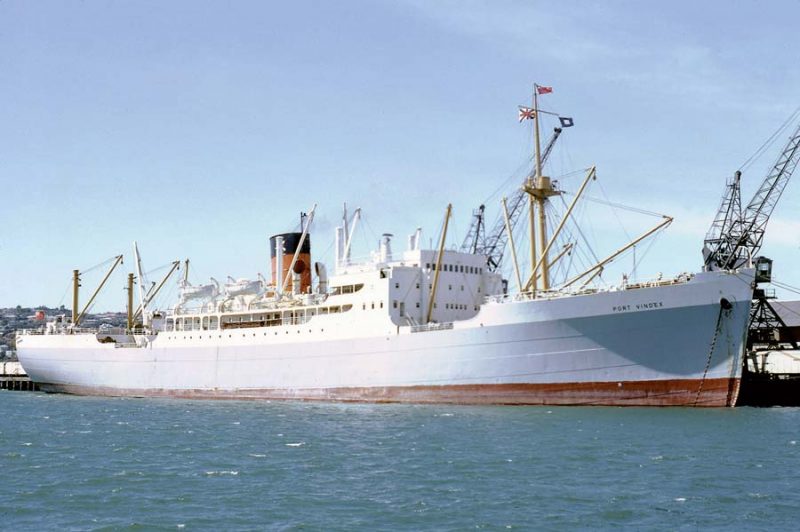
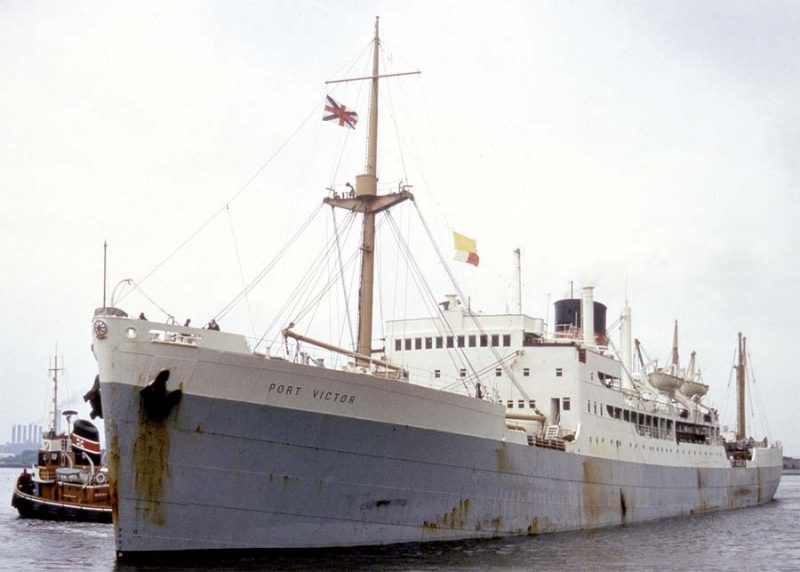
A second sister ship of Port Jackson was launched at Wallsend as Yard number 1609 on 7th October 1941 as Port Phillip and ran her trials on 20th March 1942 and was then delivered. The only minor difference from Port Jackson was that Port Phillip was completed with vertical foremast and mainmast whereas those of Port Jackson were slightly raked. Port Phillip was in collision in 1942 at Suez with Seatrain Texas 8,108/1940, a railway ship of Seatrain Lines Inc, and later that year one person was killed during gunnery practice. She survived the war and sailed on in Port Line colours but a steering fault disabled her in 1947 and she was towed into Kingston (Jamaica). She continued to sail to Australia until 1965, when she transferred to the Indian trade under charter to the associated trade of T. & J. Brocklebank, both companies being members of the Cunard Line Group. She wore Brocklebank funnel colours, and a black hull from 1968, but reverted to Port Line in 1970 and made a few more voyages in Port Line colours until she arrived at the end of her last voyage at Hong Kong on 26th January 1971, and was then broken up at Shanghai.

A third sister ship of Port Jackson was completed as Port Victor (3) after her launch at Wallsend on 27th June 1942 as Yard number 1659. She was travelling unescorted 600 miles south west of Ireland in the Atlantic when she was torpedoed at 0100 hours on 1st May 1943 by U107, fired from one thousand metres. A spread of two more torpedoes followed and unfortunately exploded under two lifeboats that were being lowered, killing all of their occupants. The ship still did not sink and a fourth torpedo was used which broke Port Victor (3) into two halves. Some 149 survivors were picked up by the frigate Wren after a Liberator aircraft had spotted the roped together boats, but ten crew members, two gunners and five passengers had been lost. She had sailed on 11th April 1943 under Capt. William Gordon Higgs on a voyage from Buenos Aires and Montevideo to Liverpool with 7,600 tonnes of refrigerated cargo, two thousand tonnes of general cargo, 87 crew members, twelve gunners and 65 passengers.
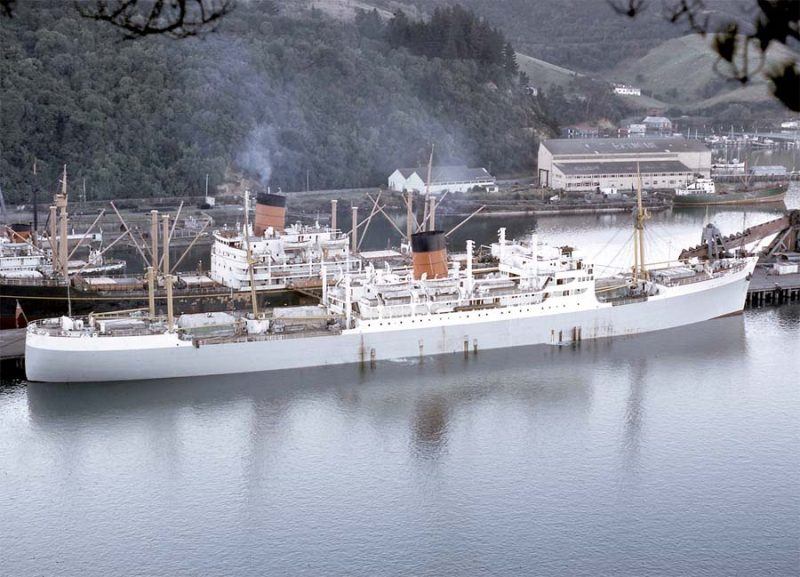
Two further wartime sister ships of Port Jackson were launched at Wallsend and Clydebank in May 1943, but were completed as the escort carriers H.M.S. Vindex (Yard number 1667) and H.M.S. Nairana equipped with Fulmer and Swordfish aircraft. The pair survived the war, with H.M.S. Vindex converted during an eighteen month refit at Wallsend back into a cargo-liner, and made her maiden voyage from London to Australia as Port Vindex on 22nd June 1949. A glass case in the passenger accommodation displayed many photographs of her wartime career as an aircraft carrier. H.M.S. Nairana was loaned to the Royal Netherlands Navy as the aircraft carrier Karel Doorman in 1946, but was also rebuilt into a cargo-liner in 1949 and renamed Port Victor (4), with both sisters voyaging to Australia for the next 22 years until broken up in 1971.

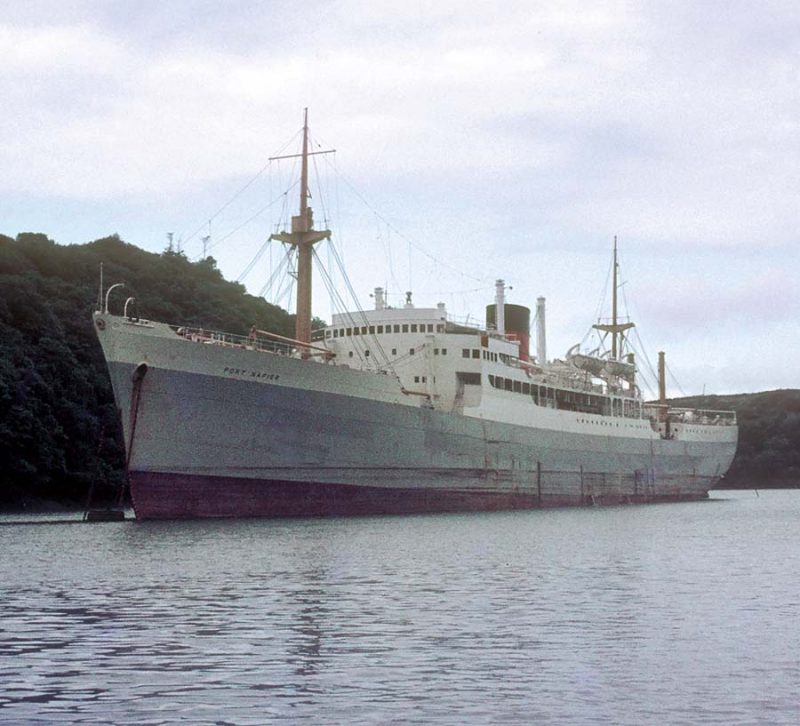
Port Jackson was a very lucky ship during wartime, as she was missed by a spread of four torpedoes from U516 (Gerhard Wiebe) on 27th August 1942 when several hundred miles west of Ireland. Capt. George Leonard Hazlewood and Mervyn Llewellyn Mather, an Engineer Officer aged 43 years, were two members of her big crew. The U-boat then surfaced and fired fourteen rounds at Port Jackson, but the gunners onboard the cargo-liner replied with very accurate fire, and the U-boat broke off the attack. Port Jackson had been hit by two shells that started a small fire, but she managed to escape at her full speed of seventeen knots and arrived safely at Liverpool two days later. She had been on a voyage from La Plata, Buenos Aires and Montevideo with refrigerated and general cargo, and had sailed from Montevideo on 9th August 1942.
Port Jackson And Her Post-War Similar Ships
Three further Port Line cargo-liners with long Bridge Decks were completed during 1946/47 as similar ships built to the prototype design of Port Jackson.
Port Pirie of 10,561 grt and a deadweight of 11,200 tonnes was launched at Wallsend on 29th May 1946 as Yard number 1741 and ran her trials on the Newbiggin Measured Mile on 30th January 1947, and sailed on her maiden voyage to Australia during the following month. She was seven feet longer than Port Jackson and had a different arrangement of posts and seventeen derricks including a heavy lift derrick at number two hold, with a Bridge Deck of length 168.0 feet, and was twin screw and powered by twin five cylinder Doxford two stroke single acting diesel engines.
Port Wellington from the Clydebank yard of John Brown & Co. Ltd. was her sister when completed in August 1946, and was the first post-war building for Port Line. Port Pirie traded for twenty five years to Australia before arriving at Castellon in Spain on 2nd July 1972 for breaking up. Port Wellington also traded for 25 years, and arrived a year before her sister at Castellon on 21st July 1971 for breaking up.
Port Napier (3) was a longer pooped version of Port Pirie and Port Wellington when launched from Wallsend on 12th November 1946 as Yard number 1749. She had a length between perpendiculars of 536.9 feet, moulded beam of 70.3 feet, and a loaded draft of 29.4 feet. Gross tonnage was 11,879 with a deadweight of 11,930 tonnes, a big cubic carrying capacity of 822,993 (grain) cubic feet of which 582,920 cubic feet was refrigerated. All three post-war similar ships to Port Jackson carried a dozen First Class passengers, Port Napier (3) having a longer Bridge Deck of 181.0 feet for better accommodation for passengers and crew, and a fo’c’stle of length 104.0 feet and a longer poop of 132.0 feet.
Thus in 1950, Port Jackson of 1937 and her six similar wartime and post-war vessels of Port Phillip of 1941, Port Victor (4), Port Vindex, Port Pirie, Port Wellington and Port Napier (3) were all engaged in the Australasian trades. Port Jackson was forced to put into Table Bay in 1952 with a smouldering fire in her cargo, which had failed to die down during the previous eight days. This group were very smart light grey hulled handsome cargo-liners with long white Bridge Decks, fo’c’stle and poop, and with derricks topped off in Australian and New Zealand waters ready for loading cargo in the many ports, including apples from Bluff. Port Pirie under Capt. Leonard J. Skailes was often seen in the New Zealand ports of Auckland, Wellington, Port Chalmers and Bluff during 1958 to 1962. Short lay-up periods were experienced during the late 1960s by this group of long bridge deck Port Line cargo-liners e.g. Port Napier was laid up in the River Fal from May to September 1967.
They usually made three round voyages per year, with Port Jackson sailing from the Thames during 1957/59 and then bunkering at Las Palmas before calling at Cape Town and Durban to reach Port Adelaide as her first Australian port of call, followed by Melbourne and Sydney. Port Adelaide by this time was a grand port with substantial stone warehouses, wharves, chandleries and pubs, and a unique metal lighthouse, and had been built some distance away from the original port built in 1869 and given the derisory name of ‘Port Misery’.
Port Jackson had a succession of Masters during this time including Capt. L. W. Cady, Capt. H. N. Conby, and Capt. J. A. Fairbairn.
Alternatively, Port Jackson would sail via Suez and Aden to Port Adelaide except when the Suez Canal was closed from October 1956 to March 1957 during the assault on Egypt and the Canal by British and French forces. When the Suez Canal reopened, she then crossed the Indian Ocean on one such voyage to reach Port Adelaide on Tuesday 3rd November 1959 under Capt. W. M. Clough.
A third possibility was to sail outwards and homewards to New Zealand ports via the Panama Canal. The M.A.N.Z. Line sailings from Canada and the Eastern Seaboard of the U.S.A. to Australasia were usually made by smaller vessels in the Port Line and Cunard Line associated fleets.
Port Jackson was sold in 1967 to Embajada Compania Naviera S.A. and renamed Legation, and made one final loaded voyage to the Far East with scrap, arriving at Kure for breaking up on 13th April 1967. The long closure of the Suez Canal from June 1967 until 1975 saw the Port Jackson type similar ships make their final voyages during 1970/72 to Australasia via the Canary Islands and Cape Town, or via the Panama Canal. Port Napier (3) arrived at Kaohsiung on 10th February 1970 after a career of 23 years. Refits and special surveys were carried out on the Tyne or at Continental ports such as Rotterdam and Antwerp.
Postscript
Although Port Jackson, her sisters and similar ships were built between seventy and eighty years ago, they were nevertheless handsome passenger cargo-liners.
They were not unique in the late 1930s, as Shaw, Savill and Albion Co. Ltd. and Blue Star Line had their own designs of long continuous bridge decked refrigerated passenger cargo-liners that could cover very long distances to bring home big cargoes from the widespread British Empire.
Immediately after the completion of the last of this Port Jackson sequence of ships, the Wallsend and Hebburn yards on the Tyne began the construction of very streamlined bridge front passenger cargo-liners for Port Line, with Port Brisbane and Port Auckland of 1949, and Port Adelaide and Port Townsville of 1951, ships that to me seemed to typify the confident nature of post-war British liner shipping that continued unabated until just after the introduction of really big container ships serving Australasia in 1969.
Port New Plymouth was launched on 29th March 1960 by Swan Hunter and Wigham Richardson Ltd. at Wallsend as the last company ship from the Tyne. She also had a long continuous Bridge Deck of 229 feet in length on dimensions of length 561.3 feet overall, moulded beam of 74.2 feet, and loaded draft of 30.75 feet. She measured 13,085 grt with a deadweight of 13,300 tonnes and a good service speed of eighteen knots from twin six cylinder Sulzer diesels from Wallsend Slipway Ltd. She took the final M.A.N.Z. sailing from Auckland to the Eastern Seaboard of U.S.A. and Canada in July 1971.
During 1972, half of the Port Line fleet of eighteen ships was disposed of, and with the sale of Port Launceston of 1957 after twenty years of service in 1977, the fleet was reduced to only five ships in Port Alfred of 1961, a ship that had been built for the M.A.N.Z. service, Port New Plymouth, Port Nicholson of 1962, and the last pair to be built in Port Caroline and Port Chalmers of 1968.
Containerisation of the Australasian trades meant that the last pair of Port Caroline and Port Chalmers went into lay up in the River Fal in 1979.
Port Chalmers made one of her last calls at Bluff for apples on 7th February 1981, while Port Caroline arrived in Kuwait later that month from European ports.
They were then transferred to the Brocklebank fleet to serve as Matra and Manaar for two more years until sold to Kappa Maritime of Greece.

They were both broken up in Shanghai in 1985, ending a great British liner fleet for which no finer tribute could be paid than that it had built every one of its 178 ships in British yards.
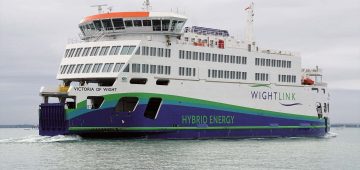



Comments
Sorry, comments are closed for this item